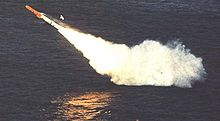
The RUR-5 ASROC is an all-weather, all sea-conditions anti-submarine missile system. Developed by the United States Navy in the 1950s, it was deployed in the 1960s, updated in the 1990s, and eventually installed on over 200 USN surface ships, specifically cruisers, destroyers, and frigates. The ASROC has been deployed on scores of warships of many other navies, including Canada, Germany, Italy, Japan, Taiwan, Greece, Pakistan and others.

A missile is an airborne ranged weapon capable of self-propelled flight aided usually by a propellant, jet engine or rocket motor.
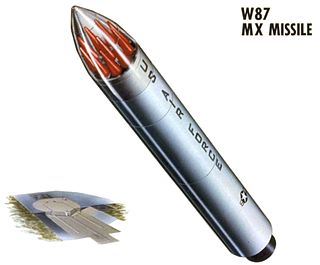
A multiple independently targetable reentry vehicle (MIRV) is an exoatmospheric ballistic missile payload containing several warheads, each capable of being aimed to hit a different target. The concept is almost invariably associated with intercontinental ballistic missiles carrying thermonuclear warheads, even if not strictly being limited to them. An intermediate case is the multiple reentry vehicle (MRV) missile which carries several warheads which are dispersed but not individually aimed. All nuclear-weapon states except Pakistan and North Korea are currently confirmed to have deployed MIRV missile systems. Israel is suspected to possess or be in the process of developing MIRVs.

The Ikara missile was an Australian ship-launched anti-submarine missile, named after an Australian Aboriginal word for "throwing stick". It launched an acoustic torpedo to a range of 10 nautical miles (19 km), allowing fast-reaction attacks against submarines at ranges that would otherwise require the launching ship to close for attack, placing itself at risk. By flying to a distant target, the engagement time was dramatically shorter than provided by short-range weapons, giving the target less time to respond.

USS Bluefish (SSN-675), a Sturgeon-class attack submarine, was the second ship of the United States Navy to be named for the bluefish.
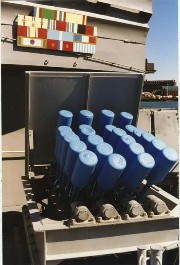
An anti-submarine weapon (ASW) is any one of a number of devices that are intended to act against a submarine and its crew, to destroy (sink) the vessel or reduce its capability as a weapon of war. In its simplest sense, an anti-submarine weapon is usually a projectile, missile or bomb that is optimized to destroy submarines.

Nuclear weapons delivery is the technology and systems used to place a nuclear weapon at the position of detonation, on or near its target. Several methods have been developed to carry out this task.

The UUM-125 Sea Lance, known early in development as the Common ASW Standoff Weapon, was to be an American standoff anti-submarine missile, initially intended to carry a W89 thermonuclear warhead. It was conceived in 1980 as a successor to both the UUM-44 SUBROC and RUR-5 ASROC anti-submarine missiles. The Sea Lance was to be available in two versions, known as UUM-125A and RUM-125A. The former would be a submarine-launched version, the latter surface-launched. It was cancelled in 1990 as its importance was obviated by the collapse of the Soviet Union.

The Popeye is a family of air-to-surface missiles developed and in use by Israel, of which several types have been developed for Israeli and export users. A long-range submarine-launched cruise missile variant of the Popeye Turbo has been speculated as being employed in Israel's submarine-based nuclear forces. The United States operated the Popeye under a different designation according to US naming conventions as the AGM-142 Have Nap.
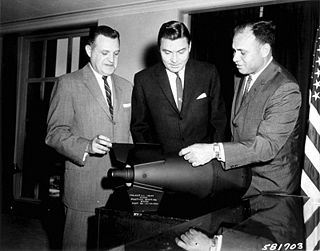
A tactical nuclear weapon (TNW) or non-strategic nuclear weapon (NSNW) is a nuclear weapon that is designed to be used on a battlefield in military situations, mostly with friendly forces in proximity and perhaps even on contested friendly territory. Generally smaller in explosive power, they are defined in contrast to strategic nuclear weapons, which are designed mostly to be targeted at the enemy interior far away from the war front against military bases, cities, towns, arms industries, and other hardened or larger-area targets to damage the enemy's ability to wage war. As of 2024, tactical nuclear weapons have never been used.
Kinglet was a boosted fission primary used in several American thermonuclear weapons.

A nuclear depth bomb is the nuclear equivalent of a conventional depth charge, and can be used in anti-submarine warfare for attacking submerged submarines. The Royal Navy, Soviet Navy, and United States Navy had nuclear depth bombs in their arsenals at one point.

A nuclear triad is a three-pronged military force structure of land-based intercontinental ballistic missiles (ICBMs), submarine-launched ballistic missiles (SLBMs), and strategic bombers with nuclear bombs and missiles. Countries build nuclear triads to eliminate an enemy's ability to destroy a nation's nuclear forces in a first-strike attack, which preserves their own ability to launch a second strike and therefore increases their nuclear deterrence.

An anti-submarine missile is a standoff anti-submarine weapon. Often a variant of anti-ship missile designs, an anti-submarine systems typically use a jet or rocket engine, to deliver an explosive warhead aimed directly at a submarine, a depth charge, or a homing torpedo that is carried from a launch ship, or other platform, to the vicinity of a target.
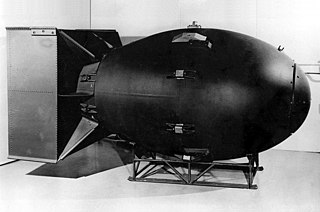
A strategic nuclear weapon (SNW) refers to a nuclear weapon that is designed to be used on targets often in settled territory far from the battlefield as part of a strategic plan, such as military bases, military command centers, arms industries, transportation, economic, and energy infrastructure, and countervalue targets such areas such as cities and towns. It is in contrast to a tactical nuclear weapon, which is designed for use in battle as part of an attack with and often near friendly conventional forces, possibly on contested friendly territory.
The UGM-89 Perseus was a proposed U.S. Navy submarine-launched anti-ship (AShM) and anti-submarine (ASW) cruise missile that was developed under the Submarine Tactical Missile (STAM) project, which was also referred to as the Submarine Anti-ship Weapon System (STAWS). This missile system was to be the centerpiece for a proposed third-generation nuclear-powered cruise missile submarine championed by then-Vice Admiral Hyman G. Rickover, the influential but controversial head of the Navy's nuclear propulsion program.
Project Nobska was a 1956 summer study on anti-submarine warfare (ASW) for the United States Navy ordered by Chief of Naval Operations Admiral Arleigh Burke. It is also referred to as the Nobska Study, named for its location on Nobska Point near the Woods Hole Oceanographic Institution (WHOI) on Cape Cod, Massachusetts. The focus was on the ASW implications of nuclear submarines, particularly on new technologies to defend against them. The study was coordinated by the Committee on Undersea Warfare (CUW) of the National Academy of Sciences (NAS). It was notable for including 73 representatives from numerous organizations involved in submarine design, submarine-related fields, and weapons design, including senior scientists from the Atomic Energy Commission's nuclear weapons laboratories. Among the participants were Nobel laureate Isidor Rabi, Paul Nitze, and Edward Teller. The study's recommendations influenced all subsequent US Navy submarine designs, as well as submarine-launched ASW tactical nuclear weapons until this weapon type was phased out in the late 1980s. New lightweight and heavyweight anti-submarine torpedo programs were approved. Although not on the initial agenda, the Polaris submarine-launched ballistic missile (SLBM) was determined to be capable of implementation at this conference. Within five years Polaris would dramatically improve the US Navy's strategic nuclear deterrent capability.

The RPK-1 Vikhr NATO reporting name SUW-N-1 was a Soviet nuclear anti submarine missile system. FRAS-1 was the NATO code for the missile round itself.
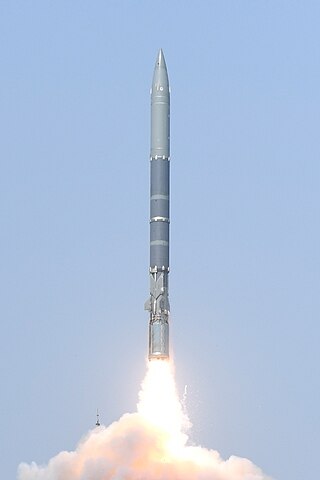
SMART is a canister-based, long-range supersonic anti-submarine missile developed by the Defence Research and Development Organisation (DRDO) for the Indian Navy.
